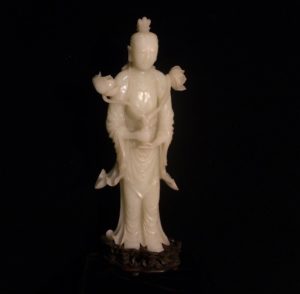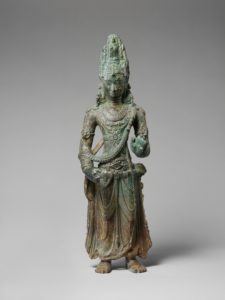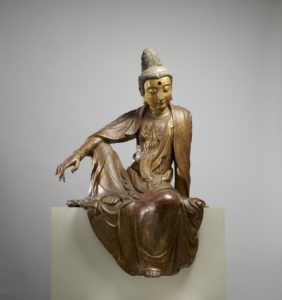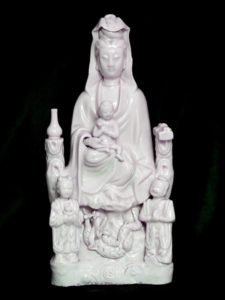
Statuette of Guanyin (Avalokiteshvara), China, Qing Dynasty, 19th-20th century, Nephrite and Teak Wood, McClung Museum, Gift of Frederick T. Bonham, 1958.5.117.
In Buddhist traditions, bodhisattvas are enlightened beings who have achieved nirvana or enlightenment, but have delayed entering paradise in order to help others achieve enlightenment, thus easing human suffering. Avalokiteshvara is the Sanskrit name of one such bodhisattva, which comes from the Lotus Sutra, one of the most important texts of Mahayana Buddhism. Avalokiteshvara is a bodhisattva who embodies the compassion of all buddhas, thus making him one of the more prominent figures in Buddhism. Chinese Buddhism translates his name is Guanyin (sometimes Guan Yin or Kuan Yin).

Standing Avalokiteshvara, the Bodhisattva of Infinite Compassion, Vietnam or Cambodia, ca. 7th century, Gilt Bronze, Metropolitan Museum of Art. Gift of Enid A Haupt, 1993.387.14.
Avalokiteshvara is referred to as male in the Lotus Sutra, and representations of him in China prior to the Song Dynasty (960-1279 CE) are masculine. Somewhere around the 12th century, portrayals of Guanyin shifted from being masculine to more feminine. Since bodhisattvas have achieved enlightenment, many have supernatural powers allowing them to change appearances in accordance with how they choose. Because Guanyin is the bodhisattva of compassion, one of their powers is the ability to bestow children. It is this power that may have led to the shift in representation of showing Guanyin in a more feminine form.

Bodhisattva Guanyin, Chinese, Late 14th-15th century (Ming), Dry Lacquer, Gold, and Paint, The Walters Art Museum, 25.256.
During this shift in representation, Guanyin became the patron goddess of mothers and seamen, and was often depicted holding a child. This led to connections being drawn between Guanyin and the Virgin Mary or Madonna figure from Christianity. For instance, from the 1600s-1800s in Japan during the Edo era, Christianity was banned and punishable by death. Some underground Christian groups would produce figures of the Virgin Mary disguised as Guanyin, known as Maria Kannon, with a cross hidden somewhere in the statue to denote her as such. Today, scholars continue to explore the connections between Mary and Guanyin and the ways in which their depictions in art and visual culture continue to overlap despite geographical and religious differences.

Maria Kannon, Dehua kiln statue of Buddhist Kannon used for Christian veneration in Japan, Nantoyōsō Collection, Japan. Courtesy of Wikimedia Commons.
Today, Guanyin not only remains one of the most beloved bodhisattvas in Chinese Buddhism, but she is also revered as an icon for many trans and nonbinary people. Her emphasis on compassion and healing along with her transcendence of gender makes her an embodiment of a non-binary experience for many. She is not only studied broadly by theologians and art historians, but is also a common motif in contemporary works of art. Queer theory scholars continue to debate Guanyin, as she can be read as androgynous, genderfluid, genderqueer, bigender, or transgender. You can learn more about Guanyin from the Museum of Fine Arts in Boston below and you can explore more Guanyin figures from the Met’s collection here.
Recently, museums like the Pitt Rivers and the V&A have made efforts to uncover “queer” narratives within their collections and exhibitions in order to provide more visibility, understanding, and representation of LGBTQ+ identities within museums. The McClung is committed to this project as well and aims to be a safe space for learning, exploring, understanding, and living LGBTQ+ experiences both for our campus and broader community. We hope that by highlighting pieces in our collection such as our statuette of Guanyin and telling these stories and histories that we may begin to undo erasure of LGBTQ+ narratives from museums.
Additional Reading:
- Bailey, Cathryn. “Embracing the Icon: The Feminist Potential of the Trans Bodhisattva, Kuan Yin.” Hypatia 24, no. 3 (2009): 178-196.
- Hedges, Paul. Guanyin, Queer Theology, and Subversive Religiosity: an experiment in interreligious theology. Brill, 2011.
- Mills, Robert. “Queer Is Here? Lesbian, Gay, Bisexual and Transgender Histories and Public Culture.” History Workshop Journal, no. 62 (2006): 253–63. http://www.jstor.org/stable/25472884.
- Vo, Dan. “The Compassionate Way: Towards Trans and Non-Binary Inclusive Narratives in Museums.” SQS – Suomen Queer-tutkimuksen Seuran lehti. 14 (2021): 95-101.